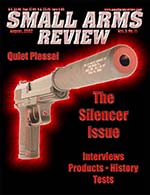Book Reviews: August 2002
By Dan Shea
Silencer History and Performance Volume II: CQB, Assault Rifle, and Sniper Technology
By Alan C. Paulson, and N.R. Parker
ISBN 1-58160-323-1
Published by Paladin Press
Softcover, 429 pages, many photos and illustrations
Review by Dan Shea
Longtime SAR Suppressor Technology Editor and contributor Al Paulson has another hit on his hands. His trilogy on Sound Suppressors is an epic undertaking. With the success of Volume I, he left the readers anticipating the next two, and I recently received a review copy of Volume II. Volume III is planned as an evaluation of the available items on the market.
In Volume II, Paulson calls upon two other authors of world renown in the small arms community, both of whom have a long history of testing and evaluating “Silencers”, SAR “Usual Suspect” contributor Neil R. Parker, and SAR Senior Editor Peter G. Kokalis. Paulson also draws on many others in the community who have extensive files and studies of various suppressors to flesh out his new work. Simply put, it is outstanding.
Suppressors, Silencers, Sound Moderators, cans, whatever you call them, can be an arcane and boring subject to write about. It is more exciting to write the exploits of the users, both real and fictional. Paulson has managed to put the technology of Volume II into a readable format, something that you can sit and actually follow the history and development of the silencer, and follow some of the exploits of those involved in development and end use. There is much to be learned. He starts in the late 1800s and follows parallel developments in different countries, and divides the journey to the modern day between types of platforms (Firearms) that the users and manufacturers have chosen.
Of great interest to many of the readers will be the development of the Maxims, the Welrods, the special series on OSS suppressors and the famous DeLisle carbine. On through the German and Combloc designs, into the Cold War and Vietnam, then to the modern day. Paulson’s work is indispensable to the serious student and the novice alike. As stated previously, the historical progression is a good tutor for a novice, and I personally used this volume to help identify several previously puzzling suppressors in various European collections that had defied identification by all who had viewed them. This book is a very useful tool for all.
This is a must have for any serious student of sound suppression in firearms, but it is also a primer on various Close Quarter Battle tool development and Sniper rifle development. Paulson’s discussions of rifle accuracy and the factors involved in some modern designs are not to be missed.
Paulson leaves us waiting for the third installment of the series, which I personally hope will be coming out soon. We say “Buy this book”, and watch for the next volume.
This article first appeared in Small Arms Review V5N11 (August 2002) |
| SUBSCRIBER COMMENT AREA |
Comments have not been generated for this article.




